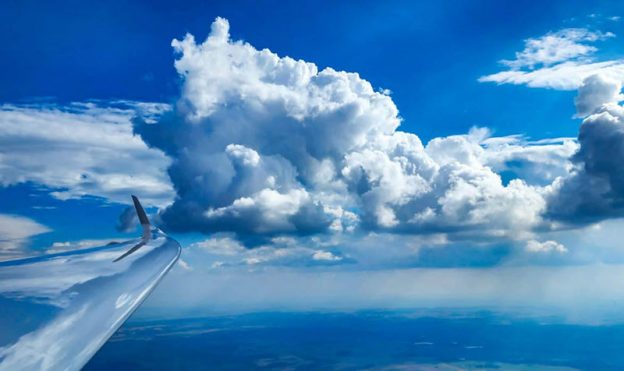
Gliding is a sport that has captivated the hearts of many over the decades. The sensation of soaring through the sky gracefully, unaided by engines or propellers, but by Mother Nature is a dream come true for many aviation-inspired enthusiasts. To allow us to achieve this silent dance with nature and the earth’s energy, one of the lift sources that glider pilots rely on, is a phenomenon known as thermals. In this article, I will try to explore the fascinating world of thermal generation, its challenges, and the importance it has in a glider pilot toolkit.
Understanding thermals
Thermals are columns of warm, rising air created by the uneven heating of the Earth’s surface. This natural phenomenon is the foundation of thermal generation in gliding. When the sun warms the ground, it heats the air directly above it. Hot air is lighter than cold air, causing it to rise. As the warm air ascends, it cools, and moisture in the air may condense, forming beautiful cumulus clouds.
Glider pilots use these rising columns of warm air to gain altitude without the need for a motor. Riding a thermal is like catching an elevator to the sky. I imagine cumulus clouds to be like the petrol stations of the sky for a glider pilot. The ability to locate, manoeuvre the glider, and then utilise thermals efficiently is a skill honed by glider pilots through training and experience.
The Science of Soaring
So, how does a glider pilot find these elusive thermals? The answer of course lies in a combination of keen observations, training, experience and skillfulll flying, which of course can be obtained by all those willing to learn!
- Observations: before takeoff, pilots will study the weather, often nowadays with applications like SkySight, or the National Bureau of Meteorology, or talking amongst local pilots to assess the local conditions to identify areas where thermals are likely to form. Once airborne, pilots will look for signs of the development of the cumulus clouds, the behaviour of soaring birds, and the differential in heat on the ground which will cause the trigging of such thermals.
- Skilful flying: Once in the air, pilots will constantly scan the landscape for visual cues that a thermal may be nearby, this may include another glider already circling in the column of lift, or sinking to show where not to go! When we encounter this rising energy, we manoeuvre the glider into a circling pattern to stay in it. Those who can race the fastest at gliding competition can find the strongest updrafts consistently…
- Navigation: To stay aloft though, and to fly great distances (sometimes gliders can fly over 1000km in a single flight!), pilots must strategically connect these thermals. They will move from one to the next, navigating using their observations from point one, their knowledge of the wind patterns and their intuition about where the next one may be!
Challenges and Rewards
Thermal generation in gliding isn’t without its challenges. Thermals can be unpredictable in terms of strength and location. A weak thermal may not even be strong enough to sustain height, while a strong one can require the pilot to make quick judgements as they near the cloud base, and sometimes if we fly high enough we must also use oxygen, as that too decreases with altitude and the pilot can’t risk becoming incapacitated.
However, the rewards of thermal soaring are immense. The joy of silent flight, the satisfaction of navigating the skies using only natural forces, and the thrill of finding and riding the thermals across great distances. It’s a deeply meditative and exhilarating experience that connects pilots with the essence of flight – I highly recommend you extend your own soaring tool kit or if you are interested in gliding, you should definitely give it a try! Source: ‚Adam Woolley, Wings & Wheels‚.


